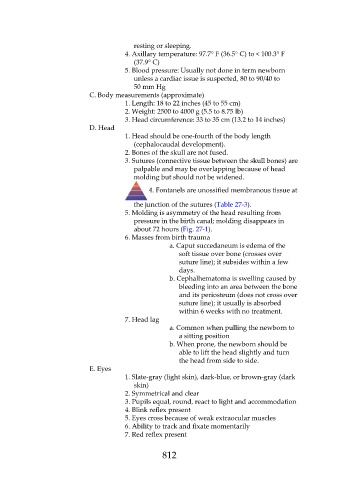Page 812 - Saunders Comprehensive Review For NCLEX-RN
P. 812
resting or sleeping.
4. Axillary temperature: 97.7° F (36.5° C) to < 100.3° F
(37.9° C)
5. Blood pressure: Usually not done in term newborn
unless a cardiac issue is suspected, 80 to 90/40 to
50 mm Hg
C. Body measurements (approximate)
1. Length: 18 to 22 inches (45 to 55 cm)
2. Weight: 2500 to 4000 g (5.5 to 8.75 lb)
3. Head circumference: 33 to 35 cm (13.2 to 14 inches)
D. Head
1. Head should be one-fourth of the body length
(cephalocaudal development).
2. Bones of the skull are not fused.
3. Sutures (connective tissue between the skull bones) are
palpable and may be overlapping because of head
molding but should not be widened.
4. Fontanels are unossified membranous tissue at
the junction of the sutures (Table 27-3).
5. Molding is asymmetry of the head resulting from
pressure in the birth canal; molding disappears in
about 72 hours (Fig. 27-1).
6. Masses from birth trauma
a. Caput succedaneum is edema of the
soft tissue over bone (crosses over
suture line); it subsides within a few
days.
b. Cephalhematoma is swelling caused by
bleeding into an area between the bone
and its periosteum (does not cross over
suture line); it usually is absorbed
within 6 weeks with no treatment.
7. Head lag
a. Common when pulling the newborn to
a sitting position
b. When prone, the newborn should be
able to lift the head slightly and turn
the head from side to side.
E. Eyes
1. Slate-gray (light skin), dark-blue, or brown-gray (dark
skin)
2. Symmetrical and clear
3. Pupils equal, round, react to light and accommodation
4. Blink reflex present
5. Eyes cross because of weak extraocular muscles
6. Ability to track and fixate momentarily
7. Red reflex present
812

